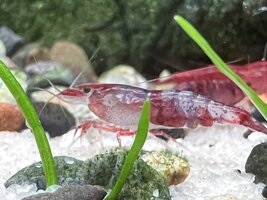Hi all,
I'm wondering if anyone can help because I'm completely baffled.
I've recently started seeing my cherry shrimp die off in pretty alarming numbers - probably on average five a day - in my 60p. This began around a month ago. Water parameters check out, and I've tested for copper. I'm dosing Tropica ferts (4ml daily) and injecting co2. Other than a couple of pest snails that must have hitchhiked in on some plants I recently introduced, I've done nothing out of the ordinary bearing in mind the scape is around 3yrs old.
That said, I have noticed that there are far fewer adult shrimp and many of those that remain have begun to lose their colouration. See the pic for an example of what I mean.
Any thoughts or suggestions on what the cause might be would be really helpful!
Cheers.
I'm wondering if anyone can help because I'm completely baffled.
I've recently started seeing my cherry shrimp die off in pretty alarming numbers - probably on average five a day - in my 60p. This began around a month ago. Water parameters check out, and I've tested for copper. I'm dosing Tropica ferts (4ml daily) and injecting co2. Other than a couple of pest snails that must have hitchhiked in on some plants I recently introduced, I've done nothing out of the ordinary bearing in mind the scape is around 3yrs old.
That said, I have noticed that there are far fewer adult shrimp and many of those that remain have begun to lose their colouration. See the pic for an example of what I mean.
Any thoughts or suggestions on what the cause might be would be really helpful!
Cheers.



